 WHERE TO GO WHERE TO GO |
 I. BELGRADE I. BELGRADE |
"The sky above Belgrade is wide and high, unstable but always beautiful; even during winter serenities with their icy splendour; even during summer storms when the whole of it turns into a single gloomy cloud which, driven by the mad wind, carries the rain mixed with the dust of panonian plain; even in spring when it seems that it also blooms, along with the ground; even in autumn when it grows heavy with the autumn stars in swarms. Always beautiful and rich, as a compensation to this strange town for everything that isn't there, and a consolation because of everything that shouldn't be there."
Ivo Andric, writer and Serbian Nobel prize laureate
 1. Introduction 1. Introduction |
Situated at the confluence of the Danube and Sava rivers, Belgrade is an ancient settlement, whose oldest archaeological findings go back to the fifth millennium BC. It was founded as Singidunum by a Celtic tribe in the third century BC, while the first mention of Belgrade dates from 989. Throughout its long and turbulent history, Belgrade was captured by forty armies and rose thirty-eight times from the ashes.
Today, Belgrade is the political and administrative capital of the Republic of Serbia. With its two million inhabitants, the city is of a major importance in traffic communications. Besides its significance as a road and rail junction, Belgrade is an important international river-to-sea, airport and telecommunications centre.
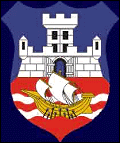
It possesses important agricultural and industrial capacities, particularly in the metal, ferrous metal and electronic industries, followed by trade and banking. The greater Belgrade area, with the cities of Smederevo and Pancevo, encompass 2000 square meters of free trade zone located on the banks of the Danube. Thirty per cent of Serbia's GNP is earned in Belgrade.
The city's vibrancy, fine restaurants, street cafes and northern European ambiance makes it an ideal place to spend a few days. Belgrade's bustling centre is Knez Mihailova, a cafe-lined pedestrian boulevard that runs northwest through the old town.
Belgrade is the capital of Serbian culture. It has the greatest concentration of science and art institutions of national importance. It is the seat of the Serbian Academy of Science and Arts (SASA), founded in 1886 as the Serbian Royal Academy; Serbian National Library, founded in 1832; National Museum, founded in 1841 and National Theatre, founded in 1869. The city is also the seat of Belgrade University, founded in 1808.
Belgrade has the status of a special district in Serbia and has autonomous authorities: the City Council, Mayor and City Government. Its territory is divided into 16 municipalities each of which has its local government.
According to 1991 census, there were 1.602.226 citizens in the larger-city area, and 1.168.454 citizens in the inner-city area. It is estimated that, today, around 2 million people live in Belgrade. The municipality with the greatest number of inhabitants - 224.424 - is Novi Beograd, while Sopot has the smallest number of inhabitants - 20.527.
 2. Climate 2. Climate |
Belgrade has a moderate continental climate, with four seasons. Autumn is longer than spring, with longer sunny and warm periods (the so-called Indian summer). Winter is not so severe, with an average of 21 days with temperature below zero. January is the coldest month, with average temperature of 0.40C. Spring is short and rainy and summer arrives abruptly.
The annual average of air temperature, between the years 1961 to 2000 was 11.90C. The hottest months are July (21.70C) and August (21.30C). The lowest temperature in Belgrade was recorded on January 10, 1893 (-26.20C), and the highest on August 12, 1921 and on September 9, 1946 (41.80C). From 1888 to 1995 Belgrade had only six days with temperature of over 400C.
Another characteristic of Belgrade climate is the so-called Košava - the southeast-east wind, which brings clear and dry weather. It mostly blows in autumn and winter, in 2-3 days intervals. The average speed of Košava is 25-43 km/h but certain strokes can reach up to 130 km/h. Košava is the largest air cleaner of Belgrade.
 3. Economy 3. Economy |
As the capital of former Federal Republic of Yugoslavia and of the new Republic of Serbia, Belgrade is the seat of numerous Federal and Republic institutions, but first of all Belgrade is an industrial, commercial, banking, educational and scientific centre, with clear defined targets in economic and social developments.
The advantages of Belgrade as the transit centre with two navigable rivers and the crossroads that connected middle with southern Europe and Middle East are worldwide recognized.
According to the Chamber of Commerce of Belgrade, the present capacities in the industry, civil engineering, trade, tourism and transport are over-dimensioned for the domestic market, mostly because they were constructed to respond to former Yugoslavia's needs. International investors will not be long to come to Belgrade, and already showed interests in investing in some areas such as energy, metal industry, electric equipment and appliances, telecommunications, chemical and pharmaceutical industry, textile industry etc … but also in the tourism and hotel industry.
With more than 1.600.000 inhabitants, Belgrade has high-developed infrastructure facilities. Further dynamic development of the town and needs for rapid, intense investments in maintenance, enlargement and modernization of the existing capacities, are profitable and moneymaking for entrepreneurs. Dynamic entrepreneurs will look at Belgrade's railway network, metro, modernization of long distance heating system, public transport and Belgrade's water economy project.
Most trade, business and exhibition events happening in Serbia take place in Belgrade.
Belgrade also hosts a Free Trade Zone, a Port, a Fair, etc.
 4. Where to go 4. Where to go |
Kalemegdan Citadel
Belgrade's fort since Celtic times, Kalemegdan Citadel looms over the old town. Most of what anybody can see there was built in the 17th century, including medieval gates, Orthodox churches, Muslim tombs and Turkish baths. Stari Grad, next to the Citadel, is the oldest part of Belgrade. There can be found the city's best museums: The National Museum, with archaeological displays and paintings; or the Ethnographical Museum, which has an excellent collection of Serbian costumes and folk art. The Gallery of Frescoes has full-size replicas of paintings from remote churches in Serbia and Macedonia. But the real "must-see" is the Palace of Princess Ljubice, an authentic, fully furnished Balkan-style palace.
The Monument to the Victor, is located in Kalemegdan park, and has been set up at a really dominating place and represents the symbol of Belgrade. It is a great work of sculptor Ivan Mestrovic. The monument was put up in 1928, made of bronze and stone, total height is about 14 metres. In 1912, Mestrovic designed a monument fountain on the theme of the liberation of Serbia from the Turks which was to have stood on Terazije. In 1928, the Victro was placed on a column in Kalemegdan, overlooking the Danube-Sava confluence, as part of the 10th anniversary celebrations of the breach of the Salonica Front.
The Cathedral "Gathering Church" was built from 1837 to 1840 in the classicist style with some late baroque features, and it was designed by the architect A.F.Kwerfeld of Pancevo. It is dedicated to the Holy Archangel Michael. The interior of this church is amply decorated. The carved and gold-plated iconostasis is the work of the sculptor Dimitrije Petrovic, and the icons on the iconostasis, in the choirs, around the throne and in the pulpit, as well as the compositions on the walls and vaults, were painted by Dimitrije Avramovic, one of the most prominent Serbian 19th century painters. The building just in front, the Patriarch's Residence, was designed by the architect Viktor Lukomski and built in 1934-35.
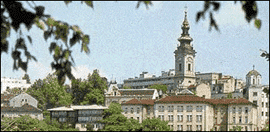
-The Cathedral "Gathering Church"-
This church's treasury is a highly valuable he church houses the relics of the holy king Uros and the holy Despot Stefan Stijanovich, as well as the tombs of Serbian patriarchs and Serbian rulers from the Obrenovic Dynasty (Milan, Milos and Mihailo).
St Mark's church
Thye St Mark's Church at Tasmajdan was build from 1931 to 1940 on the site of an old church built in 1832. It was designed by the Architects Petar and Branko Krstic in the Serbo-Byzantine style, patterned to the church of the Gracanica Monastery. According to the structure, architectural forms and facewall polychromy, this church resembles the Gracanica Monastery the most. The furbishing and the decoration of this church have yet not been completed. In the southern part of the naos, thyere lies a sarcophagus containing the relics of Emperor Dusan (1308-1355) brought from his legacy, the holy Archangels' Monastery near Prizren. This church houses one of the best collection of Serbian 18-19 century icons.
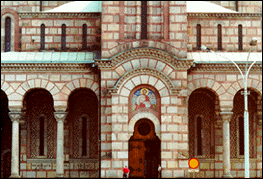
-St Mark's Church-
Terazije fountain, is situated at Terazije Square, in front of the Moskva hotel. It is made of stone, with a metal vase on the top with total height of about 8 meters. Stonemason was Pranz Loran. It was built in 1860. This is one of the most important 19th century monuments in Belgrade. When Terazije was being re-planned in 1911-1912, it was removed to the courtyard of Topcider Church. In 1979 it was returned to its old site.
Ethnography Museum, It was a part of the National Museum's ethnographic collection, but in 1901 it was turned into an independent establishment. The museum stock includes 151,990 items and the following collections: folk costumes, fabrics and carpets; implements; crafts; household furniture and dishes (wood, metal, ceramic); items associated to folk customs; paintings; old photographs, items and pictures maid of the soil; items originated from non-European peoples, etc. In the course of 90 years of its existence, this museum staged about 200 exhibitions in the country and abroad.
The National Museum, it was founded on May 10, 1844 during the reign of Prince Milos Obrenovic. It has a number of prehistoric and classic archaeological collections, collections relating to the medieval culture and arts, collections of the 18th to 20th century paintings, a good collection of foreign works of art, a rich numismatic (domestic and foreign) department and a graphic department. This is museum is also well known for its many publications and even more so for its professional library and activities of its remarkable well-developed Conservation and restoration Centre, which ranks among the biggest of the kind in the world.
The City of Belgrade Museum, was established in 1903. It has 124207 items and the following sections: pre-history, classical period, migrations and the Middle Ages; history of Belgrade and Zemun from 1521 to date; fine arts and music; applied arts and ethnology; town planning; and coins and metals. Unfortunately, this museum still has no building of its own or permanent displays…
National Theatre
National theatre was established on 13 July 1868, and from 21 November 1882 to March 1921, it was called the Royal Serbian National Theatre. It was closed during the First World War. The stage, with the ceiling and floor, was done by the machinist Veder of the Vienna Royal theatre, while the curtains and props by painter Kaucki. Only dramas were performed in until the 1919/20 season, after which it became a drama and music theatre.
Nowadays, the National Theatre drama, opera and ballet ensembles perform on three stages in Belgrade and Zemun. The performances stages by the three ensembles at home and abroad in the 125 years of the theatre's existence made an outstanding contribution to our cultural treasury.
University Park
This is in the old town core, in downtown Belgrade. Elderly Belgrade's know it as Pancic Park. In Turkish times, it was the site of the cemetery, which was removed in the middle of the 19th century, after which the biggest green market of that time, the so called Big Market, was set up in one part of the present park. Belgrade's first ever town planner, Emilijan Josimovic, felt that something more "aesthetic" than a Market would be better suited to this locality, so that in the implementation of the town plans after 1869, he halved the big market and turned the remainder of its site into a park.
The park got its first urban contours towards the end of the 19th century, when the monument to Josif Pancic was unveiled, and it was finally formed in the thirties of this century with the transfer to it of the monument to Dositej Obradivic and erection of the existing baroque fence.
Ada Ciganlija Park
Belgrade's loveliest park is Ada Ciganlija, an island in the Sava River just upstream from the city. Swim (there's an area for skinny dipping), rent a bike, sip a cold beer from one of the cafes, or just lie on your back and think peaceful thoughts.
Zemun Town Park
This is the oldest promenade and oasis of the of greenery for the townspeople of Zemun. It was laid out in 1880 as the small Park on the site of the former Zemun "Kontumac" an en-closed area of building which, from 1730, had functioned as a customs and quarantine station for travellers and goods moving between Austrian and Turkish territory.
In 1886 and 1888, further planting saw the development of the present day Town Park. Typical of the nearby buildings of the time are the former High School (completed in 1880 and extended in 1916, and known today as the Nada Dimic Educational Centre), and the Girls' School (built in 1899 and known today as the Goce Delcev Primary School). The oldest remains and monuments in the park consist of part of the old Kontumac wall, and two churches (new restored) which were part of the quarantine station , the Ortodox church of the archangel Gabriel (1789) and the catholic church of St. Rocco.(1836).
 5. Accommodation, bars and restaurants in Belgrade 5. Accommodation, bars and restaurants in Belgrade |
Belgrade's accommodation is expensive - there's a campground and a hostel in the south of the city, but otherwise you'll have to make do with a state-owned hotel. For food, cruise the Knez Mihailova or, if the budget is up to it, try one of the Bohemian quarter's folkloric restaurants.
see tables
 5. Places around Belgrade 5. Places around Belgrade |
Vinca
Situated 14 km away from Belgrade, near the Belgrade-Smederevo road, Vinca is famous for the excavations of an exceptional archaeological value. The prehistoric location of Belo Brdo is situated on the very bank of the Danube and it represents the world famous archaeological site of the remains of a large neolithic settlement, in the cultural layer 10.5 m thick, and covering an area of 10 ha. During excavations, started in 1908 by a professor of the Belgrade University, Dr Miloje Vasic, numerous houses have been discovered, the earthen homes with remains of the prehistoric man's culture. Each of the sedimented ancient layers, representing particular phases of life in Vinca (in the period about 4,500 - 3,200 B.C.), contains real treasuries of most diverse artefacts: tools and weapons of stone and bone, everyday dishes, richly decorated ritual vases, large number of anthropomorphic and zoomorphic figurines of exceptionally impressive stylization, jewelry made of different kinds of rare and precious materials and a multitude of other objects and works of art made in Vinca or acquired from distant regions - central Europe, lower Danube region or the Mediterranean. The discovered artefacts can be seen today in the National Museum of Belgrade, the Museum of the City of Belgrade, and the Vinca collection at the Faculty of Philosophy in Belgrade. Around the year 4,000 B.C. the Vinca culture has spread over the territory larger than that of any other neolithic culture in Europe. Some of its settlements, by their size and number of dwellers, have surpassed not only all contemporary neolithic settlements, but even the first towns, which came to existence considerably later in Mesopotamia, the Aegean region and Egypt.
The Vinca culture reached the peak of its development by the year 3,800 B.C. - approximately, before the other communities emerged, developing new economic and social relations, based on cattle breeding and copper and gold processing.
By the General Urban Development Plan of Belgrade, the Danube riverside in the Vinca area is declared an Archaeological Park. Besides the archaeological site, Vinca is also famous for the Vavedenje (Presentation of the Holy Virgin) Monastery of the XV century, as well as for the Institute for Nuclear Research "Boris Kidric". The archaeological site of Belo Brdo is open all year round for organized tourist visits.
 6. October 5th, 2000 6. October 5th, 2000 |
One of the brightest and most exciting moments in Belgrade's latest history was the so-called Revolution of October 5th, 2000. The Democratic Opposition of Serbia (DOS) called citizens to gather on October 5, in front of the building of the Federal Assembly, in order to resist the great vote theft made by the Federal Polling Commission by the order of Slobodan Miloševic. The DOS gave an ultimatum to Miloševic to recognize the will of the citizens, expressed in the federal, presidential and local elections of September 24, 2000, by Thursday, October 5, at 3:00 PM. It was also demanded that the general director, main editor and editorial staff of the Radio-Television of Serbia resign, and that this station change its editorial policy and provide impartial information about the events taking place in Serbia.
Vojislav Koštunica, the DOS's candidate for president, demanded from Slobodan Miloševic to recognize his defeat in the first round of elections and pointed out the danger of open conflicts in Serbia. "We can not go to any second round whatsoever, because if we did, we would become accomplices in the theft of votes. The fraud in the first round cannot be annulled by a second, fifth or who knows which round."
The supporters of DOS started to come to Belgrade in the early morning, organized from different directions, from all over Serbia, and led by the leaders of the DOS. Around 3:00 PM, the citizens gathered for the rally in front of the building of the Federal Assembly attempted to enter it. Half an hour later, a large group of them entered the Yugoslav parliament through a window. Using tear gas, the police managed to disperse at least 200,000 people from the plateau in front of the building.
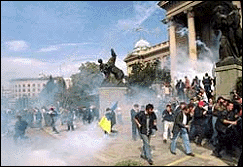
Dozens of people entered the building around 4:00 pm, while the policemen, who defended the building until then, made a retreat. Out of the right wing of the building a thick, black smoke emerged, and almost all window glasses on the building were broken. The demonstrator destroyed several police vehicles in Kosovska Street, behind the parliament building. During the fight between the police and the demonstrators gunfire could be heard. Around 5:00 PM, the commander of the Belgrade police requested to talk to the representatives of the DOS. Around six, the members of the police station in Majke Jevrosime Street put away their weapons and joined the demonstrators. Dozens of citizens with light and heavy injuries were admitted to the Urgent Aid Centre.
The police also used tear gas near the building of the Radio-Television of Serbia, while a loader started to make its way to the entrance. The building of the RTS in Takovska Street was then set on fire, and the RTS ceased broadcast after 5:00 PM. All three channels of the state TV station started to broadcast music, commercials and previously recorded programs. In the afternoon, the Radio-Television Studio B started to broadcast regular reports about the situation on the streets. Later, one by one, all other TV stations began to report about the real events on the streets of Belgrade.
The new elected president of the FR of Yugoslavia, Vojislav Koštunica addressed the citizens in the afternoon, from the balcony of the building of the City Assembly of Belgrade, and later he appeared in the program of the Radio-Television of Serbia. During that evening, a constitutive meeting of the new City Assembly of Belgrade was held. Hundreds of thousands of people spent the night in the centre of Belgrade, celebrating the victory, but also fearing of possible intervention of the Army and other security forces of the former regime. The Democratic Opposition of Serbia formed a crisis staff for the key positions in the country in coordination with the new president, and during the night, the DOS representatives had talks with the heads of state and public security services. In front of the building of the City
Assembly, a great number of people welcomed the new morning. A new morning for the city and for the country. (We thank the City Assembly for the information on October 5th)
 II. VOJVODINA / KOSOVO AND METHOHIA II. VOJVODINA / KOSOVO AND METHOHIA |
 1. Vojvodina 1. Vojvodina |
This province of Serbia occupies the area of 10,849 square kilometres of the territory in the North-East of the Republic. Novi Sad is its administrative, economic and cultural seat.
Vojvodina makes almost a quarter of the Serbian territory or 21,506 square kilometres. Novi Sad is the administrative, economic and cultural seat of the province.
A. Novi Sad
Where to stay in Novi Sad:
There are 6 major hotels in Novi Sad. All of them are very close to key points of Novi Sad like centre of the city, bus or railway station.
The oldest and most appealing of Novi Sad's six hotels is Hotel Vojvodina right on Trg Slobode. With an attractive pastel façade, it's conveniently located.
Attractions to see in Novi Sad:
Novi Sad is a town where there are so many tourist attractions. One could just take a walk through the centre of the city to find that out.
Petrovaradin's Fortress:
Petrovaradin's fortress is being recognised as a symbol of Novi Sad. It rises on the right bank of river Danube on the vertical volcanic rock. It dominates view of Novi Sad and Backa province's fields.
It's located only 800 meters from the very centre of the city. You can get there by three bridges spanning the river. There you will find peace, arranged and protected space, magnificent sightseeing of this beautiful town.
Religious temples:
Today in Novi Sad live more than 26 different nationalities. There are more than 6 religious groups (orthodox, catholic, uniat, evangelistic, jewish, kalvinist...) whose religious temples are spread all over Novi Sad. Different ethic groups, which found in it peace and serenity, combined with mutual understanding and tolerance.
Museums:
History did not always left traces visible to people. Sometimes traces were buried very deep in the ground from where they had to be extracted through a patient process of archaeological exploration. Many things discovered this way reside now in museums of Novi Sad.
Monasteries of Fruska Gora:
During the course of history people suffered 500 years long occupation of most of it's native territory by Turkish empire following the defeat on Kosovo polje battle in 1389. Many monasteries were destroyed and lots of churches turned into horse stables.
Many of monks and priests along with the river of refugees escaped Turks and went to Vojvodina which was part of Austro-Hungarian empire.
B. Subotica
At 10 km at the border at Kelebija, Subotica is useful transit point from SZEGED (Hungary). The train station is just a short walk from the centre of town.
Thing to see: The imposing Art Nouveau Town hall (1910) contains an excellent historical museum.
 2. Kosovo and Methohia 2. Kosovo and Methohia |
Things to see in Pristina:
The Kosovo Museum building has been appropriated by the EU, but the artefacts are crowded onto the first floor. Most of the best exhibits were removed to Belgrade but there are new items covering the KLA campaign - see the clothes of their gun runners. Behind are two mosques: Sultan Faith (the larger) and Jashar Pasha with some nice decorative work.
 III. MONASTERIES OF SERBIA III. MONASTERIES OF SERBIA |
 DJURDJEVI STUBOVI DJURDJEVI STUBOVI |
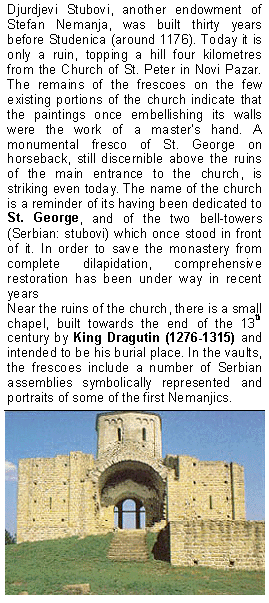
 GRADAC GRADAC |
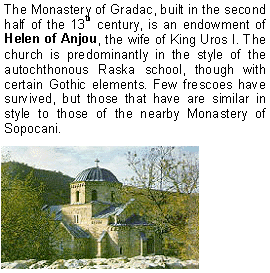
|  KALENIC KALENIC |
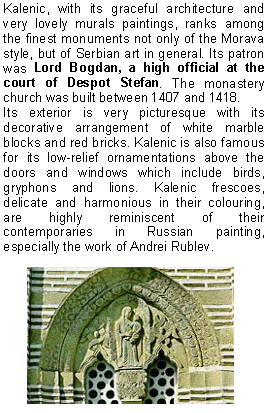
 KRUSEDOL AND HOPOVO KRUSEDOL AND HOPOVO |
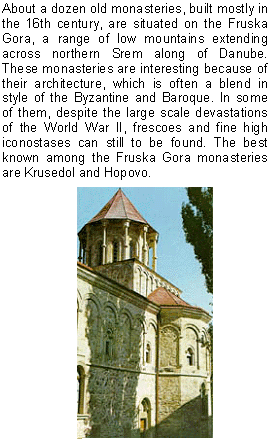
 LAZARICA LAZARICA |
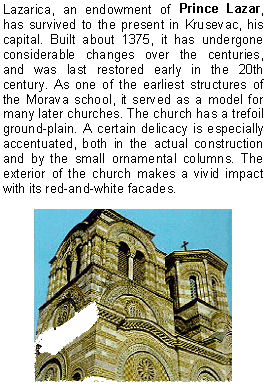
 LJUBOSTINJA LJUBOSTINJA |
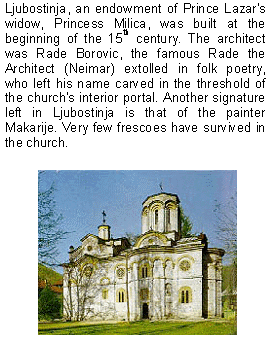
 MANASIJA MANASIJA |
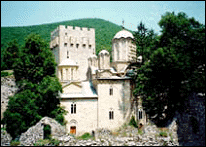
Manasija (Resava) was built early in the 15th century. Its founder was Dt Stefan, the son of Prince Lazarespo. In the Middle Ages, the monastery was known as Resava.In contrast to all other churches of the Morava style, marble was exclusively used in its construction.Built at a crucial moment in the history of the medieval Serbian state, Manasija was transformed into a by stronghold, encircled with massive walls, fortified with eleven defensive towers. The fortifications are still well preserved.Besides the monastery church, parts of the old refectory and library have also survived at Manasija. The library-housed manuscript workshop where the many books required by the Church were copied. The "Resava" script was highly valued and for a long time served as the model for subsequent scribes.
 NAUPARA NAUPARA |
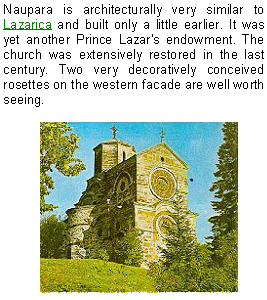
 PEC PEC |
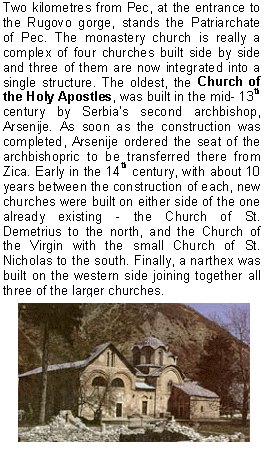
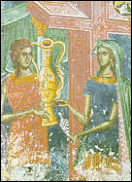
The frescoes in these churches belong to various periods. The oldest, in the sub-dome of the Church of the Holy Apostles, date back to the time of its construction, the first half of the 13th century. In forceful expression, general concept and size, they belong to the 13th century monumental painting with its clearly defined features (Studenica, Mileseva, Sopocani). In the dome, the apostles, angels and the Assumption of the Virgin are very impressive. The paintings in the front of the church are from the 14th century, and closely related to the frescoes in the Church of St. Clemence in Ohrid. A small portion of the frescoes in this part of the church belong to the 17th century.
Most of the frescoes in the Church of St. Demetrius were painted by the master painter Jovan, who left his signature, in Greek, in the altar area where it can still be seen. These works differ considerably from those of the 13th century and those of the Milutin period. Particularly characteristic is the artist's evident devotion to detail. The Handmaid with the Jug, a detail in The Birth of the Virgin of the altar apse, has become well-known in the art world for the figure's charm and its classical beauty.
The monastery treasury housed in the Church of St. Demetrius, includes a number of icons, volumes in manuscript and gold and silver items. The icons were made in the Pec workshop, which was particularly active in the second half of the 16th century.
 PRIZREN PRIZREN |
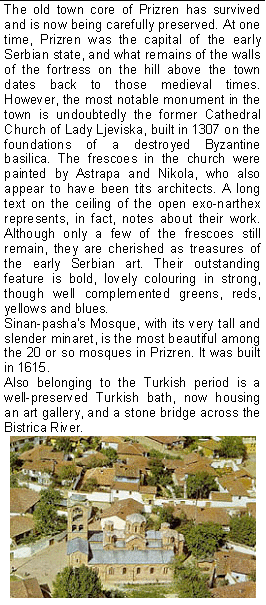
 SOPOCANI SOPOCANI |
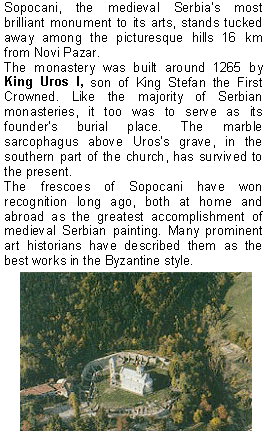
 STUDENICA STUDENICA |
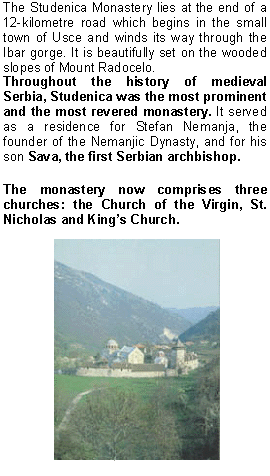
 VISOKI DECANI VISOKI DECANI |
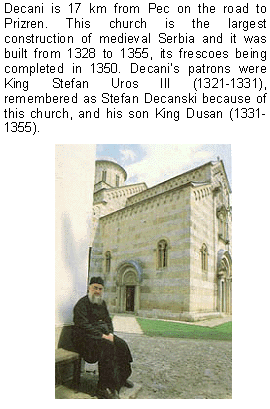
 ZICA ZICA |
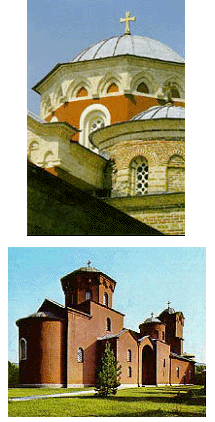
Zica Monastery, an endowment of King Stefan the First Crowned built between 1208 and 1220, lies in a plain near Kraljevo, at the entrance to the Ibar gorge. Zica was the first seat of the autonomous Serbian Archbishops and it was there that almost all medieval Serbian rulers were crowned.
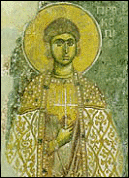
Architecturally, Zica belongs to the Raska school, characterized by the Romanesque style of the Littoral adapted to the needs of the Orthodox religious service. However, more in keeping with the tradition of the Mount Athos monasteries, Zica was originally painted red.
Only a few of the old frescoes dating back to the 13th century still remain in this church. These frescoes can be seen mainly in the lateral choir recesses. The rest of the wall paintings are from the early 14th century. The fine frescoes in the south chapel, dedicated to St. Stefan, belong to this period.
 IV. SKIING IN SERBIA IV. SKIING IN SERBIA |
 1. Sara - Brezovica 1. Sara - Brezovica |
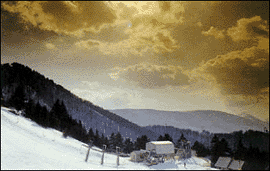
Brezovica - a well-known mountain tourist resort on the northwest slope of Mt. Sara - a unique recreational complex at an altitude of 900 to 2,500 metres.
Climatic conditions, snow from November to May, professional and amateur ski trails and skiing slopes, by their adequate inclinations, high quality and long-term snow cover, rank Brezovica among the best recreational centres.
The terrain of this centre has prepared trails for all the Alpine disciplines, within a space of 3,0000 metres, so the active presence of 50,000 skiers is possible.
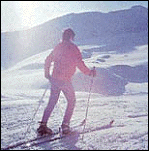
The airports in Pristina and Skoplje are very near (about 60 km), and there are also very good roads leading to Brezovica.
The attractive Molika hotel is at an altitude of 1,750 metres.
Tourist and cultural attractions within a circle of 100 km include the cities of Prizren, Pec and Pristina, and such cultural and historical attractions as the Gracanica and Decani monasteries, etc.
 2. Kopaonik 2. Kopaonik |
Kopaonik is the largest mountain in Serbia, more then 100 km long. Its highest peak is Suvo Rudiste (also called Pancic's Peak) at 2,016 m above sea. The duration and quality of snowfall and ideal skiing grounds have been attracting a rapidly increasing number of guests.
Kopaonik was declared a national park in 1981. The national park spreads on 12,000 hectares. A vast high mountainous and relatively flat region at an altitude of about 1,700 meters forms the basis of this national park.
This central Kopaonik plateau is called Suvo Rudiste. It is surrounded by mountain peaks. To the north and northwest of this plateau stretches Banjski Kopaonik below which is the well-known Josanicka Banja spa with its strong springs whose waters reach the temperature of 88 degrees Celsius. Directly below the Suvo Rudiste plateau starts the attractive and picturesque valley of the Samokovska River, characterized by its steep run, numerous rapids, falls and gorges.
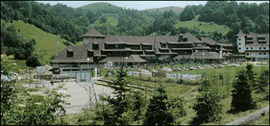
Kopaonik's flora is characterized by a large number of autochthonous plant species (the Balkan beech, fir, spruce, yew, several kinds of maple, pine and oak). The fauna is also diverse but its concentration varies, depending on the quality of the habitat.
This mountain has enormous resources for the development of tourism. The entire park is characterised by its extraordinary natural beauty: vast expanses of grassland, picturesque forests composed of a wide variety of tree species, beauty spots, deep river gorges. The snow blanket lasts a long time on this mountain and in view of its good relief, there are excellent conditions for the further expansion of winter tourism there.
The tourist resort on the Kopaonik includes hotels, rest houses, ski lifts, excellent ski slopes and many other tourist facilities.
The Kopaonik is well-connected with the main transport routes in Serbia. The central part of Kopaonik with the tourist centre and ski slopes is linked with the Ibar Highway by a modern tarmac road. The nearest airport is in Nis.
Information:
Tourist Office of Raska, tel: +381 36 736 085
Tourist Office of Brus, tel: +381 37 825 185
Hotel Grand****, tel: +381 36 / 71 027, 71 010
Villa Ivana, tel: +381.63379298 (highly recommended!)
Apartment Complex JAT****, tel: +381 36 71 013
Apartment Complex Kopaonik***, tel: +381 37 823 130
 V. HUNTING AND FISHING V. HUNTING AND FISHING |

From the Pannonia plain in the north, to the mountain massifs in the south, a true lover of nature, of wilderness and action, is offered numerous challenges in the rich hunting grounds of Serbia. Some animal species already exterminated in other parts of Europe still live in the green marshlands and dense forests here. The hunting grounds are easily accessible from the larger cities and the game in them can suit different tastes - and different pockets. There are hotels and hunting lodges both in most hunting grounds.
Get your hunting gear. We are waiting for you in Karadjordjevo, Morovic, Kozara, Apatin, Crni Lug, Delibatska Pescara, Ecka, on Sara, Prokletije, Juzni Kucaj, Deli Jovan, Tara, Zvezda...
Follow the trail....of deer, fox, wolf, roe, deer, wild boar, rabbit, bear, pheasant, partrige, chamois, eagle, hawk, wild duck. Due to the large variety of the game, there are hunting seasons throughout the year - one will surely suit you.
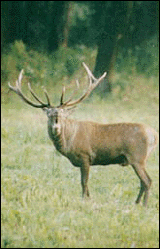
If you are one of those people who like to study nature with a keen eye and a pair of binoculars only, the marshes of Carska and Obedska Bara have a date with you, with more than 200 species of birds and armloads of exotic marsh flowers.
Cast a line with a baited hook into the waters of... the rivers Sava, Tisa, Danube, Morava, Drina, Ibar, Crni Timok, Nisava, Kolubara, Mlava to catch carp, catfish, pike, sturgeon, perch, bass, trout, bream, salmon.
The 35 fishing centres in Serbia, in addition to a good catch, offer fun and good company. If you believe you have what it takes to be a good chef, beside being a lucky angler, you can enter the "Gold Kettle of Danube" competition; or just enjoy the fish stew containing more than 50 types of fish prepared by an experienced fisherman-cum-chef.
One thing is sure: upon return from a hunting or angling expedition in Serbia you won't have to think up a tall angling or hunting story. You will have experienced it. |

